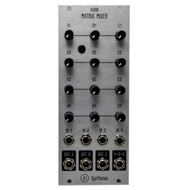AI Synthesis - AI008 Matrix Mixer
by Ellison Wolf
Waveform contributor Abe Ingle’s AI Synthesis' Matrix Mixer is the newest release from AI Synthesis and an excellent project for those looking to add a versatile utility module to their system, and add to their DIY synth building resumé.
Even though the demo module sent to me was fully built, looking it over it seems to be a pretty straightforward project to DIY as all of the components are through hole, and even though this is a 2 layer PCB project, it looks simple enough to attach them and shouldn’t present any problems when tackling the build.
Matrix mixers can be confusing at first glance, with their usual gridlock of knobs and jacks, but they are somewhat basic in concept, and are used to route audio or CV signals from multiple inputs to multiple outputs. Simple, right? The AI008 is buffered and DC coupled, and has 4 inputs [1-4], and 3 individual outputs [A, B, C] with one summed output [A+B+C], for a total of 4. With 12 potentiometers [4 inputs x 3 outputs [minus the summed output] = 12] to dial in the amount each input will send to each individual output, there is a lot of flexibility. Now, as far as matrix mixers go, I think this is the most compact one I’ve come across for Eurorack. There are a few with less inputs/outputs, but other than that, the AI008 takes up a minuscule amount of space—only 10 HP— for what it can do.
In terms of layout, the AI008 is also about as straightforward as you can get. Each of the three vertical rows of potentiometers represents each input’s value going into the 3 separate outputs [A, B, C]. If we take the A row [A1, A2, A3, A4], that means that A1 is the value of Input 1 going into Output A. A2 is the value of Input 2 going into Output A, and so on. Just the same, B1 is the value of Input 1 going into Output B, B2 is Input 2 going into Output B, and on and on. At its most basic, I use this to send each input to more than one effect [delay + reverb, for example], and also to send multiple inputs to each effect. Since a lot of effects—and modules in general—only have 1 input, this allows you to precisely mix more than one signal into the given effect, and in this way, it’s pretty much being used as a standard effects send on a mixer, which is helpful because I don’t have a ton of modules and need to maximize what I get out of each, especially effects. Being able to send multiple voices into one reverb, and being able to control how much of each voice is hitting that reverb is the real deal, and with the AI008, you could have 4 different voices all being thrown into each of 3 different reverbs, delays, or whatever. That’s a lot of functionality, and a ton of flexibility.
Where a matrix mixer really shines though, is when you start patching it back into itself, and/or use it to patch a module into itself, enabling you to create feedback loops, which works great with time-based effects such as delays, reverbs, phasers, etc. It can take a little fiddling to be able to get musical feedback and not just a high pitched whistle or what sounds like a deep moan, [“Ugh. You’re using me for a feedback loop again?”, says the oft abused spring reverb unit], which is why it’s so helpful to have the attenuators to dial in the right amount of signal.
Using the Matrix Mixer to route affected oscillators back into their FM inputs yielded some pretty interesting sonics, and if you’ve never mixed your LFOs and ADSRs together, then make sure you have an oscilloscope handy so you can see the craziness that can ensue. Using the Matrix Mixer is a great way to create really obscure envelope shapes and gates/triggers/pulses that are pretty hard to do otherwise. You can be pretty careless in terms of what goes into the input and the unconventional shapes [and thereby sounds when patched into a voice] that you’ll get will never be the same twice.
Like I said, this is a very straightforward matrix mixer, and I found it really versatile, and nearly indispensable, when wanting to get the max usage out of my spring reverb [NOT just for feedback, thank you very much!], which has only 1 input. Being able to then put that into my Erica Synths Dual FX for some delay, and dial in input signal for the right the delay amount for each individual input was a treat. Feeding all of that back into itself via the Matrix Mixer really helped usher in a new dimension to both my patch and my patching. I hadn’t thought much about the fact that I didn’t have a matrix mixer, but it would be hard to go back now. It’s like unseeing something that you already had seen: impossible to do. The Matrix Mixer got me hooked on something I didn’t really know that I even needed, and once you get a taste of the AI008, you’ll start to see how creating more complex patches can be made a little bit easier—truly a good thing.
10HP 17mA +12V 17mA @ -12V
Price: From $15-125


